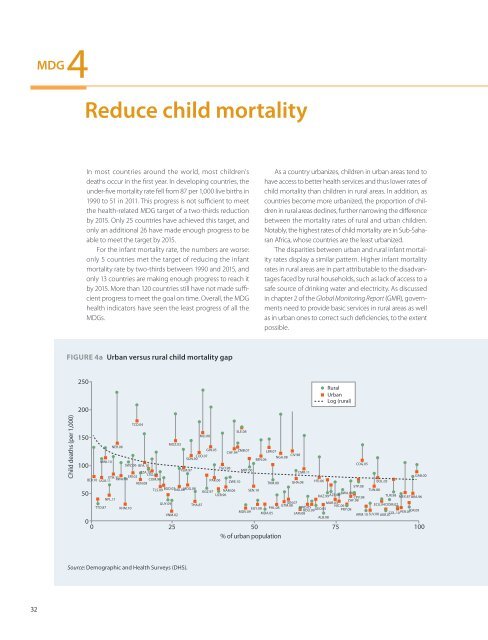rural-urban dynamics_report.pdf - Khazar University
rural-urban dynamics_report.pdf - Khazar University
rural-urban dynamics_report.pdf - Khazar University
Create successful ePaper yourself
Turn your PDF publications into a flip-book with our unique Google optimized e-Paper software.
MDG<br />
4<br />
Reduce child mortality<br />
In most countries around the world, most children’s<br />
deaths occur in the first year. In developing countries, the<br />
under-five mortality rate fell from 87 per 1,000 live births in<br />
1990 to 51 in 2011. This progress is not sufficient to meet<br />
the health-related MDG target of a two-thirds reduction<br />
by 2015. Only 25 countries have achieved this target, and<br />
only an additional 26 have made enough progress to be<br />
able to meet the target by 2015.<br />
For the infant mortality rate, the numbers are worse:<br />
only 5 countries met the target of reducing the infant<br />
mortality rate by two-thirds between 1990 and 2015, and<br />
only 13 countries are making enough progress to reach it<br />
by 2015. More than 120 countries still have not made sufficient<br />
progress to meet the goal on time. Overall, the MDG<br />
health indicators have seen the least progress of all the<br />
MDGs.<br />
As a country <strong>urban</strong>izes, children in <strong>urban</strong> areas tend to<br />
have access to better health services and thus lower rates of<br />
child mortality than children in <strong>rural</strong> areas. In addition, as<br />
countries become more <strong>urban</strong>ized, the proportion of children<br />
in <strong>rural</strong> areas declines, further narrowing the difference<br />
between the mortality rates of <strong>rural</strong> and <strong>urban</strong> children.<br />
Notably, the highest rates of child mortality are in Sub-Saharan<br />
Africa, whose countries are the least <strong>urban</strong>ized.<br />
The disparities between <strong>urban</strong> and <strong>rural</strong> infant mortality<br />
rates display a similar pattern. Higher infant mortality<br />
rates in <strong>rural</strong> areas are in part attributable to the disadvantages<br />
faced by <strong>rural</strong> households, such as lack of access to a<br />
safe source of drinking water and electricity. As discussed<br />
in chapter 2 of the Global Monitoring Report (GMR), governments<br />
need to provide basic services in <strong>rural</strong> areas as well<br />
as in <strong>urban</strong> ones to correct such deficiencies, to the extent<br />
possible.<br />
FIGURE 4a Urban versus <strong>rural</strong> child mortality gap<br />
Child deaths (per 1,000)<br />
250<br />
200<br />
150<br />
100<br />
TCD.04<br />
MLI.06<br />
SLE.08<br />
Rural<br />
Urban<br />
Log (<strong>rural</strong>)<br />
MOZ.03<br />
NER.06<br />
GIN.05<br />
CAF.94 ZMB.07<br />
LBR.07<br />
COD.07<br />
CIV.98<br />
SDN.90<br />
NGA.08<br />
BEN.06<br />
MWI.10<br />
SWZ.06 BFA.10<br />
COG.05<br />
TGO.98<br />
YEM.97<br />
MRT.00<br />
TZA.10<br />
CMR.11<br />
ETH.11 ERI.02<br />
LSO.09<br />
GAB.00<br />
BDI.10 UGA.11<br />
RWA.10<br />
COM.96<br />
PAK.06<br />
KEN.08<br />
ZWE.10<br />
TKM.00 GHA.08 HTI.06<br />
BOL.03<br />
TLS.09 BGD.07<br />
STP.08<br />
IND.06MDG.08<br />
KGZ.97 NAM.06 SEN.10<br />
TUN.88<br />
UZB.96<br />
KAZ.99 AZE.06 BWA.88<br />
TUR.98<br />
CPV.98<br />
MEX.87 BRA.96<br />
NPL.11<br />
ZAF.98<br />
GUY.09<br />
IDN.07<br />
MAR.03<br />
THA.87<br />
GTM.08<br />
TTO.87 KHM.10<br />
EGY.08 PHL.08<br />
HND.05<br />
NIC.06<br />
ECU.04 DOM.07<br />
MDV.09<br />
ROU.99 GEO.05 PRY.08<br />
VNM.02<br />
MDA.05<br />
JAM.08<br />
ARM.10 SLV.08 COL.10<br />
UKR.07<br />
PER.07 JOR.09<br />
ALB.08<br />
50<br />
0<br />
0 25 50<br />
75<br />
100<br />
% of <strong>urban</strong> population<br />
Source: Demographic and Health Surveys (DHS).<br />
32

















